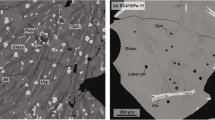Abstract
The dependence of iron and europium partitioning between plagioclase and melt on oxygen fugacity was studied in the system SiO2(Qz)—NaAlSi3O8(Ab)—CaAl2Si2O8(An)—H2O. Experiments were performed at 500 MPa and 850 °C/750 °C under water saturated conditions. The oxygen fugacity was varied in the log f O2-range from −7.27 to −15.78. To work at the most reducing conditions the classical double-capsule technique was modified. The sample and a C—O—H bearing sensor capsule were placed next to each other within a BN jacket to minimise loss of hydrogen to the vessel atmosphere. By this setup redox conditions slightly more reducing than the FeO—Fe3O4 buffer could be maintained even in 96 h runs. Raman spectra showed that the BN was modified by reaction with hydrogen resulting in a low hydrogen permeability. The partition coefficients determined for Eu at 850 °C and 500 MPa vary from 0.095 at conditions of the Cu—Cu2O buffer to 1.81 at the most reducing conditions (C—O—H sensor). In the same f O2 interval the partition coefficient for Fe varies from 0.55 at oxidising conditions to 0.08 at the most reducing conditions. The partitioning of Sm, which was added as a reference for a trivalent REE, does not vary with the oxygen fugacity, yielding an average value for D = 0.07. Lowering the temperature to 750 °C for a given f O2 decreases the partition coefficient of Eu and increases that of Fe. Comparison with published data at 1 atm and at higher temperatures shows that both temperature and composition of the melt have strong effects on the partitioning behaviour. As the change of the partition coefficients in the geologically relevant f O2 range is quite strong, element partitioning of Eu and Fe might be used to estimate redox conditions for the genesis of igneous rocks. Furthermore, by modelling the partitioning data it is possible to extract information about the redox state of the melt. Resulting ferric-ferrous ratios show significant differences from those predicted by empirical models.
Similar content being viewed by others
Author information
Authors and Affiliations
Additional information
Received: 14 October 1998 / Received: 5 March 1999
Rights and permissions
About this article
Cite this article
Wilke, M., Behrens, H. The dependence of the partitioning of iron and europium between plagioclase and hydrous tonalitic melt on oxygen fugacity. Contrib Mineral Petrol 137, 102–114 (1999). https://doi.org/10.1007/s004100050585
Issue Date:
DOI: https://doi.org/10.1007/s004100050585




